Wildscaping Bark Butter Recipe
by Trish Meyer – January 2015.
Yes, this is long! Hopefully the amount of detail is helpful and not overwhelming. If nothing else, it will help ME to read these notes so I don't forget the recipe!
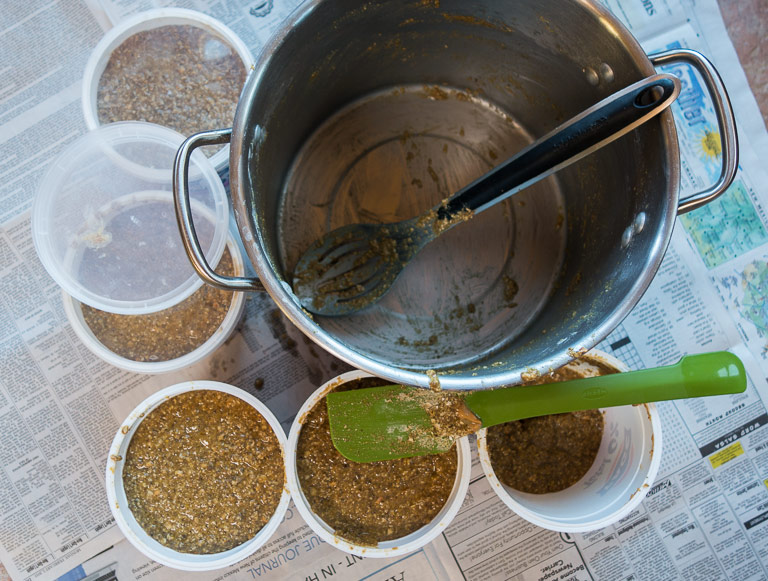
Step-by-step recipe for making homemade bark butter – and it's more nutritious too!
While there are many recipes for homemade bark butter for birds, we really liked the "spreadable" suet we found in the commercial Birdacious Bark Butter at Wild Bird stores. If you want to first determine if it's worth making it at home, try a commercial brand with your birds first!
Our birds devoured it(!) and we were soon going through one container a week. At about $14 each, that was adding up! So I set out to find a homemade replacement that would cost less. I found I could make it at home for about a quarter of the price, so could afford to give the birds twice as much for half the cost! Plus, a container makes a nice gift to give to a bird-loving friend or neighbor over the winter holidays.
I read many blog entries before starting to experiment with making Bark Butter. This was the best resource imo:
Julie Zickefoose discovered that bark butter needs more nutrition added via chick starter mix: http://juliezickefoose.blogspot.com/2010/03/zick-dough-improved.html
VIDEO on how she makes it: https://www.youtube.com/watch?v=I9_oOhXNG6A
My recipe is very similar to hers, although I add more peanut butter to make it stickier, and I heat my flour so can use less (flour becomes glue when heated). I also “grind” the dry ingredients in a blender (or food mixer) to make it nice and smooth just like the commercial bark butter (if it's worth doing at all, it's worth doing right!)
Feel free to adapt this recipe to suit your preference for how sticky or crumbly it is. Be sure to include the Chick Starter mix though, as I believe it is important for the bird's health so they get enough nutrients and avoid problems with bone density.
Also, I do NOT add seeds! It read somewhere that seeds need to be hulled as they are eaten, so birds would be swallowing unhulled seed if you mix seed in. However, I think you could add "hulled sunflower chips", as this would be akin to the chunks of peanut that is in chunky peanut butter.
You can buy all the ingredients below at CostCo, Kroger and other supermarkets, with the exception of Chick Starter crumbles which you'll need to get from an animal feedstore.
 Chick Starter Crumbles: Feedstores sell 5lb or 25lb sacks and it's cheap (cheep?!). Be sure to get the NON-medicated version! You don't want wild birds using antibiotics! The “starter” means it's for baby chicks and includes protein and nutrients for healthy growth. It should look like CRUMBLES (and not lumps of corn and grit meant for larger fowl). The crumbles grind up easily in the blender too.
Chick Starter Crumbles: Feedstores sell 5lb or 25lb sacks and it's cheap (cheep?!). Be sure to get the NON-medicated version! You don't want wild birds using antibiotics! The “starter” means it's for baby chicks and includes protein and nutrients for healthy growth. It should look like CRUMBLES (and not lumps of corn and grit meant for larger fowl). The crumbles grind up easily in the blender too.
I buy a big sack of chick starter mix at the beginning of the winter and store it in a metal container in the garage with a small container for scooping out (see image, right); a 20 or 25lb bag will last all season.
Amazon also carries regular chick starter mix: Manna Pro Chick Starter Non-Medicated Crumbles 5lb
If you want to spoil your birds, Amazon sells Organic, non-GMO chick starter mixes (search for best price).
I buy regular peanut butter in bulk from Costco (both the Creamy and Chunky jars); the birds didn't like the low-sugar healthier version! The rest of the ingredients I get at a supermarket, buying whichever brand is on sale.
I use a Blender to grind down some of the chunkier dry ingredients, so check out local Thrift Stores. (A food mixer might also work.) You may not want to use your good stuff as the chick starter mix is not for human consumption. Same with all the utensils in the "box o' stuff" (see below) – I keep a separate set of utensil just for the birds!
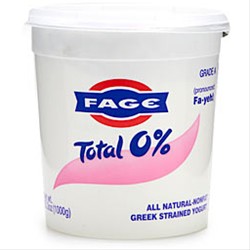 The "Tub" Measurement
The "Tub" Measurement
After I wasted time weighing each of the dry ingredients, I now cheat and use an empty plastic "tub" of FAGE Yogurt - make sure it's the 1000g size (not the larger 1360g size). I just fill up this "tub" and skip all the weighing! It's SO much easier than measuring "cups" or "oz" or weighing anything. You will need at least TWO of these "tubs".
THE COOKING KIT
Big stuff from your kitchen:
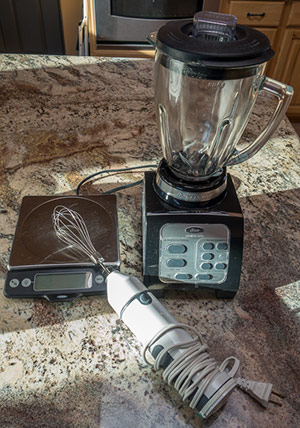
- Blender (for grinding down dry ingredients to finer quality; try to find old one OR clean your good one well after grinding chick starter)
- Electronic weighing scale – can use your good one as only for human food (lard & peanut butter)
- Electric hand whisk – optional but useful for blending the flour into the melted lard/PB mix (all human food)
- if not using electric whisk, use a large strong metal whisk
Box of Utensils
(check local Thrift Stores for most of these!)

I keep a box of utensils in the garage for making bark butter so it's all in one place:
 notebook so you can keep notes as you refine the steps and recipe to suit your style of working
notebook so you can keep notes as you refine the steps and recipe to suit your style of working- one large stock pot (for melting wet ingredients and for mixing it all together at the end)
- one metal serving spoon (for scooping out the lard and peanut butter from their containers)
- one medium-size container for weighing the lard and peanut butter on the scale (gets messy!)
- one silicone spatula is handy for pushing the lard and peanut butter from the medium container into the stockpot
- the important spoon is one large strong metal spoon (the final mix is hard to stir together). We use a Caphalon stainless steel spoon, the type that no one uses anymore because they scratch non-stick pots (see photo, right)
- one large mixing bowl for mixing the dry ingredients together (before adding to stock pot)
- TWO empty FAGE Yogurt 1000g plastic "tubs" (these are used for measuring dry ingredients)
- A bunch of empty containers with lids for storing the finished bark butter
- newspaper to spread on the kitchen floor when mixing the wet & dry ingredients in the final step
When cooking is done:
- a cool place to store the cooked bark butter (we use the cold floor of our food pantry)
- one spatula for smearing the bark butter on the tree (a cheap Home Depot spackling spreader works well)
- a large box to hold all the utensils and containers; plus space to store the left-over ingredients
INGREDIENTS for ONE Batch
(makes about 4 tubs of bark butter; I recommend making 2 batches in one session)
WET ingredients (use weighing scale):
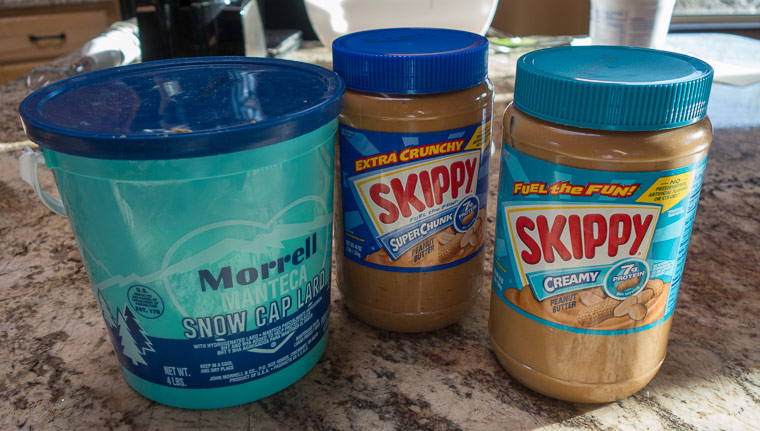
- 2lb (=32 oz) Lard
(Morrell Snow Cap Lard at Kroger comes in convenient 1lb blocks, as well as a 4lb tub) - 2lb 6oz (=38 oz) Peanut Butter
(the original recipe is for 2lb, but adding more makes it easier to spread, less crumbly)
(I use half/half Creamy & Crunchy from Costco)
- 3 cups of All-Purpose Plain White Flour – see tip below for making a handy "cheat" container
DRY ingredients:

(a "tub" = FAGE 1000g plastic tub, measured up to the line that is 1" from the top, not the very top)
- 2 tubs (or a little less) – Chick Starter (NON-medicated) crumbles (OR measure out 8 cups worth)
- 2 tubs – Quick 1-Minute Oats (OR measure out 8 cups worth)
- 24 oz Yellow Corn Meal (no weighing required if you buy 24oz container)
HOW TO MAKE BARK BUTTER
QUICK OVERVIEW of major steps (more details below):
- Melt the "wet stuff" – Lard and Peanut Butter – in the stock pot on LOW heat on the stove.
- Grind the “dry stuff” – Chick Starter and Quick Oats – then mix with the Corn Meal in large bowl.
- Whisk the flour with the melted lard & peanut butter and heat. Remove from stovetop.
- Add the “dry” mix to the stockpot while stirring continuously (two people are better than one for this step!)
- Scoop the warm mixture into empty containers and cool.
Store one container at room temperature for easier spreading, and store the others in a cool place until needed.
The next morning (or in a few hours), the bark butter will be firm and ready to feed to the birds!
Each batch will make about 4 tubs (FAGE 1000g size) of bark butter. Because it takes time to clean up the mess(!), I try to make TWO batches in one session.
DETAILED STEPS in order of appearance:
- Check that you have ALL the ingredients (make a shopping list when you start on the last tub of the previous batch)
- Put the stock pot on the stovetop.
- Put the medium mixing bowl on the scale (the large one is used for the dry ingredients).
If using an electronic scale which turns off automatically, write down how much the empty bowl weighs in your notes! - Set the scale to Zero Out (so that scale reads 0).
- Lard: If you are using 1lb blocks of lard, empty 2 blocks into the pot.
- OR – if using the 4lb tub of lard, you'll need to weigh it: Using the serving size metal spool, scoop 2 lbs of Lard onto bowl on scale
(If you are slow about it, and the scale turns itself off, you'll need to add the weight of the empty bowl to the 2lbs. So your recipe should have two values for weight: Lard and Lard+Bowl!). - Using a silicone spatula, scoop the lard out of the container into the stockpot on stove
- Set burner to LOW heat (2 or 3 out of 10). There's no rush. Put on the lid if you have one.
- Peanut Butter: Weigh out 2lb 6oz on the scale in the same container, using a mixture of Creamy and Chunky peanut butter if you like.
(Again, make a note of how much PB + weight of container adds up to, in case scale turns itself off.) - Using the spatula, add the PB to the lard in the stock pot – which should now be starting to melt.
(The medium bowl can now be used for a spoon rest to keep messy stirring spoons off the countertop.) - Stir the wet ingredients occasionally as they melt and keep the temperature low so things are only melting, NOT bubbling. (Low = 2 or 3 on a scale from 1-10.)
Note that chunky peanut butter will have lumps so this mix will never be 100% smooth.
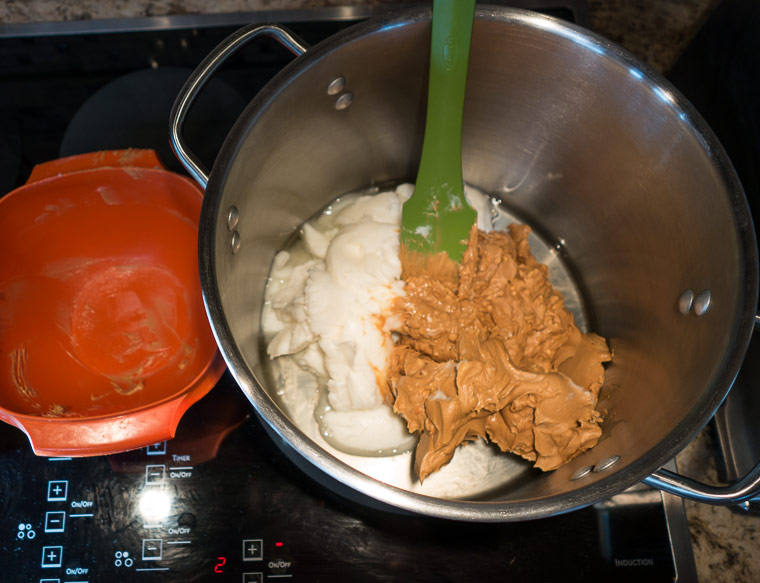
Now turn your attention to the dry ingredients:
Grind Chick Starter
- Plug in the blender (which should be beefy enough to crush ice without blowing a fuse…)
- Measure out TWO “tubs” of crumbles. As mentioned above, a “tub” is a FAGE Yogurt 1000g container, up to the top line about 1" from the top.
(Don't use one tub and fill it twice, as it's easy to lose count as you're blending...ask me how I know!) - With TWO tubs full, put HALF of one tub into the Blender and put on the lid(!)
- Blend on LOW for 30-45 seconds or so until it's finely ground down (see image below). YMMV here.
I don't try to blend a whole tub at once – it does not blend very well and so doesn't really save time!
Note that the FAGE containers are wider at the top, so “half” the tub is a bit deceptive. - Pour the finely ground results from the blender into the LARGE mixing bowl
- Repeat: Keep blending half a tub at a time until it's all ground down and in the large mixing bowl.
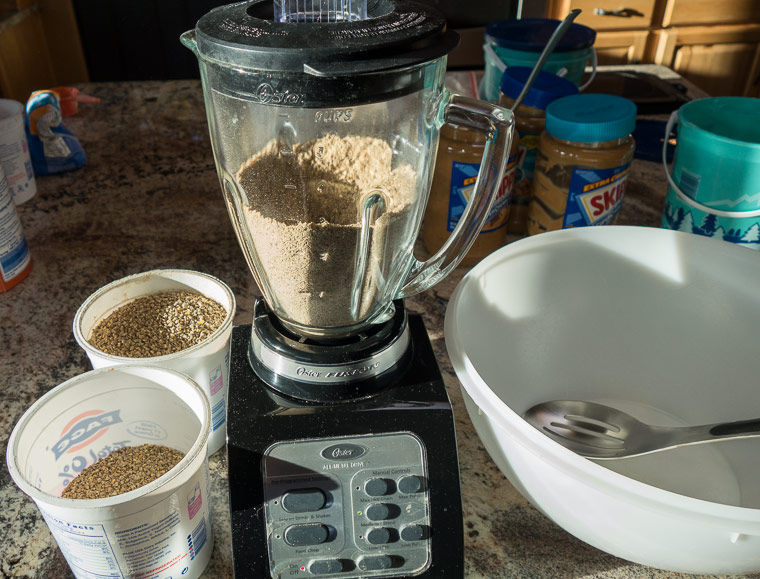
- Don't forget to apologize for horrible noise to significant other who is trying to watch TV in the next room...
- Check on the melting lard and PB and make sure it's not getting too hot and give it a stir.
Grind Quick 1-Minute Oats:
- Measure TWO “tubs” of Quick Oats (in the same FAGE containers you used for the Chick Starter)
- This is ground down the exact same way as the Chick Starter, a half tub at a time, but it's quicker to blend and less noisy!
- Add the ground oats to chick starter in the large mixing bowl.
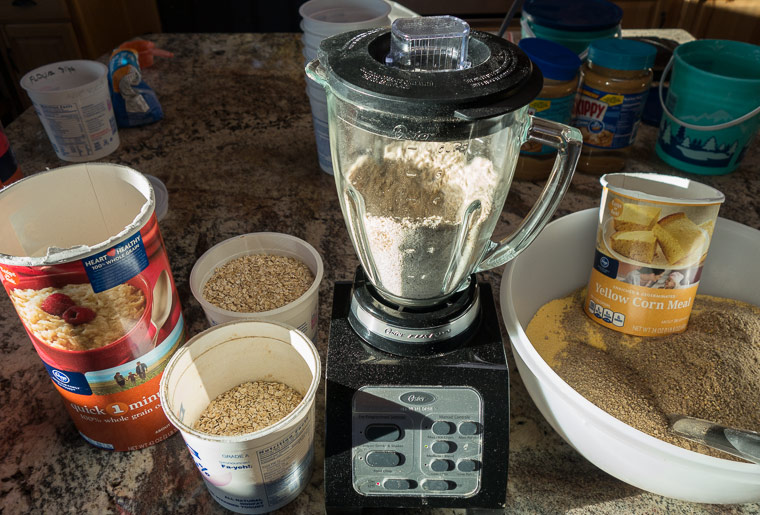
Add Corn Meal:
- Open 24oz container – no measuring needed! Pour into the large mixing bowl with the ground chick starter and oats.
- Using the large metal spoon, mix all 3 of the dry ingredients well.
- Resist the urge to add the flour to the dry mix!
- Check on the stock pot again and give it a stir – the lard & peanut butter should be pretty much all melted now. Don't overheat.
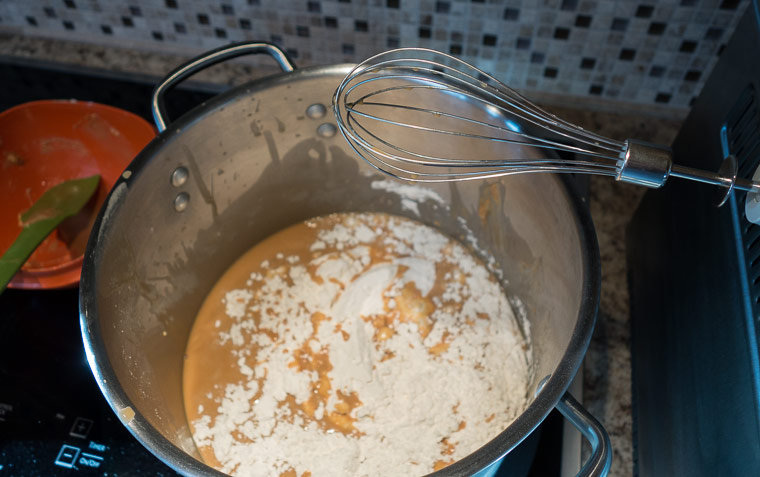
Add Flour To Stockpot:
- Plug in the electric hand whisker (if using one) near the stock pot, or use a manual large whisk.
- Measure 3 cups of All Purpose Plain White Flour (see also tip below for “cheat” container).
- Gently add the flour into the melted mix of lard/PB, and using a whisk, turn it over gently until it's all damp (otherwise it may fly everywhere when whisked!).
- If using an electric whisk, turn it on and whisk for a few minutes until all the flour is absorbed well (this works also with a hand whisk, it just takes longer and is tiring!).
- Continue stirring until the mix gets a little bubbly; it's okay if the mix heats up almost to a slight simmer as the heat activates the “gluey” property of the flour (see note below).
- Turn OFF the heat on stove and see if someone with big biceps can help with the next step (every home should have one)....
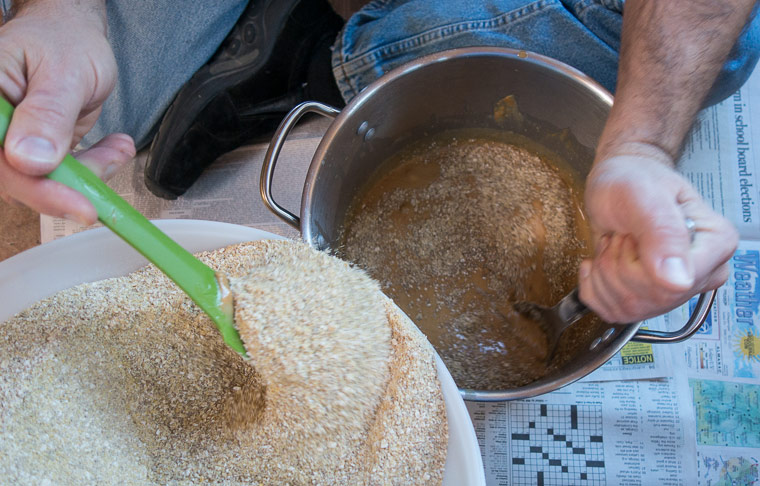
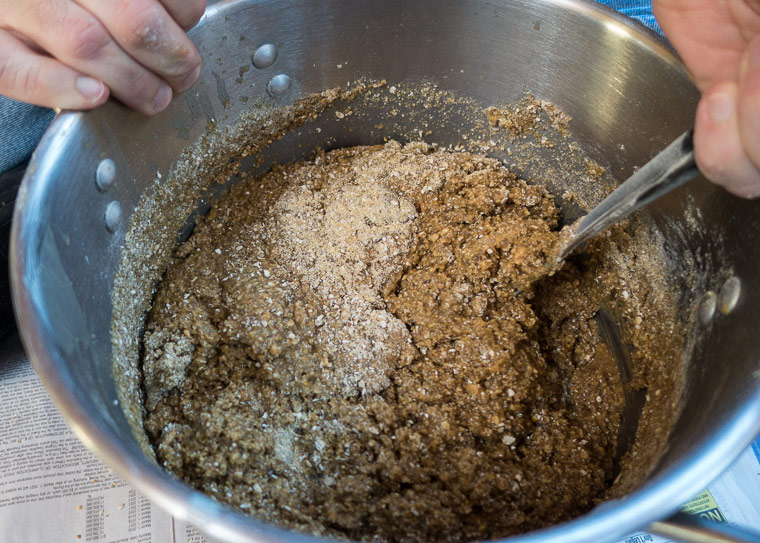
The Final Mix
- Array some old newspaper on floor of kitchen
- Put stockpot on newspaper (can use old heat mat under it, or a folded newspaper)
- If you have two cooks, one person can stir the melted stuff with the large strong metal spoon while second person tilts the dry ingedients into it using the spatula. It will be very easy at first, then get harder as more is added.
- Once it's as mixed as can be (no dry bits showing), use the spoon to scoop it into your storage containers; put on the lids.
- You can reuse all the dirty containers and utensils if making a second batch (if not, start the cleanup!)
- We leave the extra bark butter containers on a cold floor in the pantry, and keep one at room temperature.
- As you put things away, make a Shopping List of which ingredients are running short of so you can buy them for next time.

Feed the Birds!
The next morning (or a few hours later), use a spackling spatula to smear some bark butter on a tree branch, in little nooks and crannies of the tree, or in special bark butter bird feeders. Try to put some low down on an easy stump or hollow, where towhees and other birds that don't “cling” can get to it.
Try not to feed bark butter too late in the day; if it's left out overnight it will freeze hard and only the woodpeckers will be able to eat it! We usually feed them when we get up, and if the weather is bad we'll give them extra at lunch time.
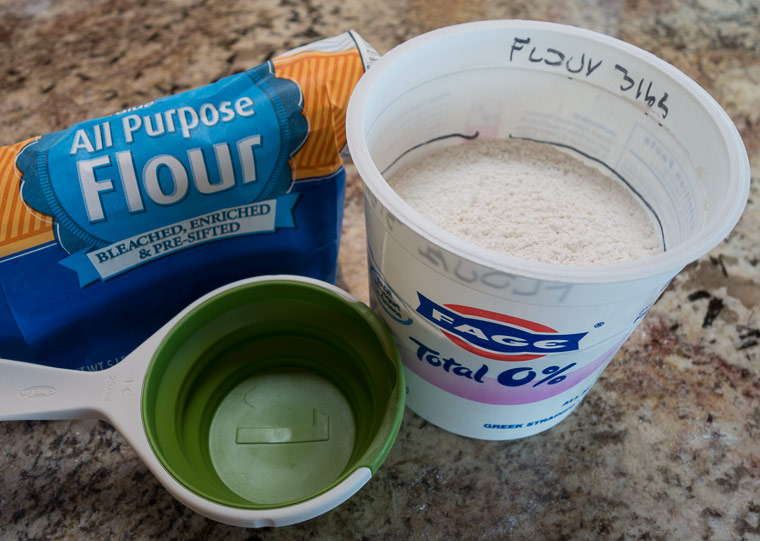 Tip: Create a "cheat" measuring tub for the flour:
Tip: Create a "cheat" measuring tub for the flour:
This saves measuring the flour each time, so you only have to do it once!
Carefully measure the 3 cups of All Purpose Flour, leveling off each cup. Pour the flour into a large yogurt container (an extra FAGE 1000g tub works fine here too). Rock it gently until the flour is level and not peaked in the center. Take a Sharpie pen and draw a line around the top of the flour (see image, right). This line is how far up to measure the flour the NEXT time. Keep this marked container in your kit when you're done and you’ll never have to measure the flour carefully again!
Notes:
Most of the recipes add the flour to the dry ingredients. However, I believe the flour is added to make the ingredients bind together. If so, it makes more sense to me to activate the flour with heat (flour+water+heat = wheat paste/glue). Once I started doing it this way, the flour the bark butter held together better, reducing the “crumbliness”. I could also cut back on the flour (from 4 cups to 3 cups).
The original recipes online call for equal part lard and peanut butter, but we found that was too dry. When we tried to smear it on the tree branch, it would crumble and fall. Adding more PB made it stickier. Heating the flour seems to make it stickier too. So after a few experiments, we settled on the recipe above.
The first few times I made it, it took me so long I thought I'd never make it again! But once I had organized my box of utensils, and practiced a few times, I can now make the first batch in about 45 minutes from start to finish, then the second batch takes about 30 minutes, plus cleanup and time to put everything away. So allow 1.5 hours total for two batches once you get organized.
Depending on how much you spoil your birds, how bad the weather, and the number of birds you have, a tub will last from a couple of days(!) to two weeks. In very bad weather, we feed twice a day (morning and lunch).
And just wait until you see how many birds will be lining up and tweeting for you in the morning, and how much they enjoy it!
© 2015–2021 Trish Meyer, Wildscaping.
Feel free to link to this page, but please do not copy and paste into your own blog. You know why.
Sorry there are no comments; this is an old static website that is never going to get Wordpress-ized! If you'd like to send me feedback, please email me Trish:




